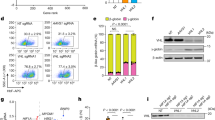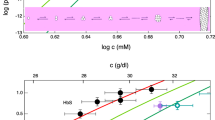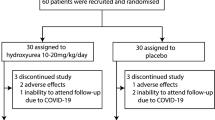Abstract
DURING human foetal development, the predominant haemoglobin in erythrocytes switches twice (Fig. 1). First, ɛ chains of embryonic haemoglobins in erythroblasts of yolk sac origin are replaced by γ chains of foetal haemoglobin and traces of β chains of adult haemoglobin. This switch occurs very early in foetal development, coincident with the appearance of a new type of peripheral erythrocyte of hepatic origin. Second, at about 32 weeks of gestation, predominantly γ-chain production gives way to increased β-chain synthesis within a constant cell type1. This double haemoglobin switch also occurs in other animals, including sheep2. Not only is very little known about the biological basis for the switch from γ- to β-chain production, but the basic changes in gene activity involved in the switching process are obscure. An understanding of the γ to β switch has clinical importance, for if one could block the switch and increase γ-chain production, sickle cell anaemia and β-thalassaemia could be treated effectively. We present here data concerning changes in globin gene activity, as assessed by globin mRNA levels, which are temporally related to the turning up of β-chain synthesis. These observations were originally made in erythroid cells of aborted human foetuses and were extended to cells from foetal sheep.
This is a preview of subscription content, access via your institution
Access options
Subscribe to this journal
Receive 51 print issues and online access
$199.00 per year
only $3.90 per issue
Buy this article
- Purchase on Springer Link
- Instant access to full article PDF
Prices may be subject to local taxes which are calculated during checkout
Similar content being viewed by others
References
Kazazian, H. H., Jr, Sem. Hemat., 11, 525–548 (1974).
Hammerberg, B., Brett, I., and Kitchen, H., Ann. N. Y. Acad. Sci., 241, 672–681 (1974).
Evans, M. J., and Lingrel, J. B., Biochemistry, 8, 3000–3005 (1969).
Aviv, H., and Leder, P., Proc. natn. Acad. Sci. U.S.A., 69, 1408–1412 (1972).
Gould, H. J., and Hamlyn, P. H., FEBS Lett., 30, 301–304 (1973).
Kazazian, H. H., Jr, Snyder, P. B., and Cheng, T-c., Biochem. biophys. Res. Commun., 59, 1053–1061 (1974).
Morrison, M. R., Brinkley, S. A., Gorski, J., and Lingrel, J. B., J. biol. Chem., 249, 5290–5295 (1974).
Berns, A., Jansen, P., and Bloemendal, H., FEBS Lett., 47, 343–346 (1974).
Hamlyn, P. H., and Gould, H. J., J. molec. Biol., 94, 94, 101–109 (1975).
Forget, B. G., Housman, D., Benz, E. J., Jr, and McCaffrey, R. P., Proc. natn. Acad. Sci. U.S.A., 72, 984–988 (1975).
Kazazian, H. H., Jr, Ginder, G. D., Snyder, P. G., VanBeneden, R. J., and Woodhead, A. P., Proc. natn. Acad. Sci. U.S.A., 72, 567–571 (1975).
Mathews, M. B., and Korner, A., Eur. J. Biochem., 17, 328–343 (1970).
Cividalli, G., Nathan, D. G., Kan, Y. W., Santamarina, B., and Frigoletto, F., Pediat. Res., 8, 553–560 (1974).
Huisman, T. H. J., and Schroeder, W. A., CRC Crit. Rev. clin. lab. Sci., 1, 471–526 (1970).
Hollenberg, M. D., Kaback, M. M., and Kazazian, H. H., Jr, Science, 174, 698–702 (1971).
Kazazian, H. H., Jr, and Woodhead, A. P., New Engl. J. Med., 289, 58–62 (1973).
Author information
Authors and Affiliations
Rights and permissions
About this article
Cite this article
KAZAZIAN, H., SILVERSTEIN, A., SNYDER, P. et al. Increasing haemoglobin β-chain synthesis in foetal development is associated with a declining γ- to α-mRNA ratio. Nature 260, 67–70 (1976). https://doi.org/10.1038/260067a0
Received:
Accepted:
Issue Date:
DOI: https://doi.org/10.1038/260067a0
This article is cited by
-
Biosynthesis of cat hemoglobins: Translation of poly(A)-RNA from animals of various HbA/HbB phenotypes
Biochemical Genetics (1984)
Comments
By submitting a comment you agree to abide by our Terms and Community Guidelines. If you find something abusive or that does not comply with our terms or guidelines please flag it as inappropriate.



